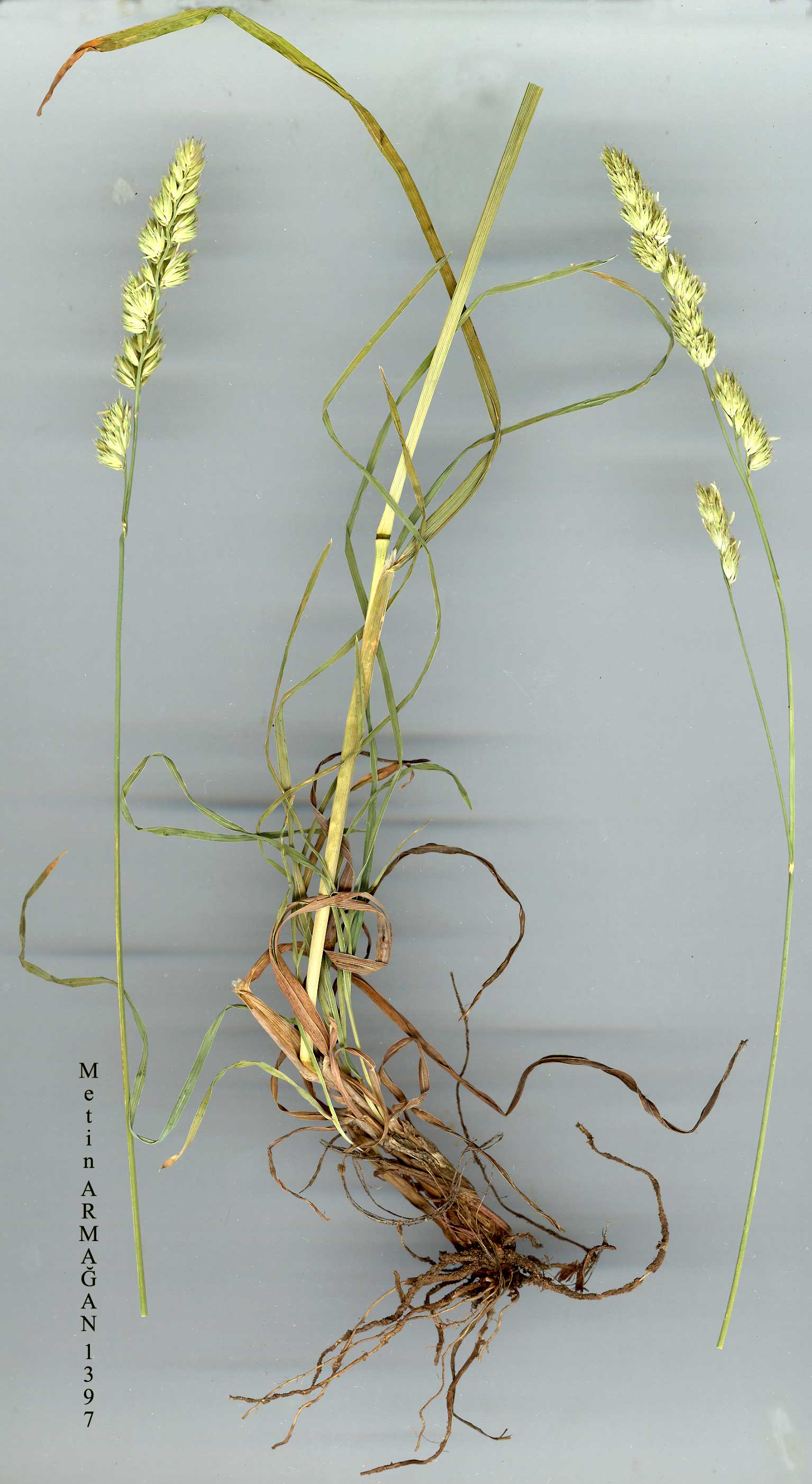| Poaceae |
|---|
 NYMAN _jpg.jpg)
Dactylis glomerata L. subsp. hispanica (ROTH) NYMAN |
 NYMAN_jpg.jpg)
Dactylis glomerata L. subsp. hispanica (ROTH) NYMAN |
 Dactylis glomerata L. subsp. hispanica (ROTH) NYMAN |
Dactylis L. |
D. glomerata L., Sp.Pl. 71 (1753). Coarse stiff caespitose perennial with short praemorse rhizome. Stems (lü-)l5-100 cm or more, erect or decumbent, with 2-3(-4) nodes; vegetative shoots ± strongly compressed. Ligule (l-)2-8(-10.5) mm, acute or lacerate. Leaf blades narrowly linear, 3-30(-40) cm x 0.5-5(-6) mm, glaucous or dull green, scabrid. Panicle 1-18 cm, with or without distinct branches to 7 cm, (in Turkey) often reduced to an ovoid to oblong head of subsessile fascicles of spikelets. Spikelets 5-9 mm, crowded in fascicles, 2-5-flowered. Glumes lanceolate to ovate, long-acute, lower (2.2-)3.5-6(-6.5) mm. Lemma lanceolate, lowest 4-6(-7) mm, acuminate or emarginate at apex, muticous or with a mucro or short subterminal awn to 1.5 mm. Anthers 1.8-4 mm. 1. Lemma emarginate at apex, with short, stout awn or mucro in fissure T subsp. hispanica 1. Lemma acuminate at apex 2.Inflorescence subsecund with filiform panicle branches; leaves flaccid subsp. lobata 2. Inflorescence not secund, with stouter panicle branches; leaves not flaccid subsp. glomerata subsp. hispanica (Roth) Nyman, Consp. 819 (1882). Syn: D. hispanica Roth, Cat. Bot. 1:8 (1797);D. glomerata L. var. hispanica (Roth) W. Koch, Syn. Fl. Germ. 808 (1837). Ic: Fl. Iraq 9: t. 26(1968). Fl. 4-8. Forests, steppe, rocky slopes, hillsides, fields, roadsides, sand dunes, s.1,-2900 m. Type: [Spain] semina hujus plantae inter Passulas Majores legi, Roth (nolo. Natural History Museum, Oldenburg). Almost throughout Turkey, Islands. A1(E) Tekirdağ: Yenice (S. of Inecik), 610 m, E. Anglia Exped. F9! A1(A) Çanakkale: Dardanelles, Nagram, Sint. 1883:64! A2(E) Istanbul: Kila (Kilyos), s.l., 28 v 1905, Azn. (as f. ammophila Heldr.)! A2(A) Istanbul: Prinkipo (Büyük Ada), 27 v 1905, B. Post! A3 Bolu: Ala Da., Kartal Kaya, Khan et al. 494! A4 Ankara: Hacikadin De. nr Keçiören, D. 18808! A5 Sinop: Samsun to Sinop (Gerze), 250 m, Tobey 1041! A7 Trabzon: Beştaşköy, 9.7 km S. of citadel, 265 m, Dent 72! A8 Çoruh: Tiryal Da., 570 m, Düzenli 621! A9 Erzurum: 3 km W. of Oltu, 25 vi 1967, J.G. Ross! Bl Izmir: Kemalpaşa, Alava&Bocquet 5010! B2 Kütahya: Gediz, 850 m, D. 36613! B3 Konya: Akşehir to Örkenez, 1500m, Sorger 78-20-5(!). B5 Nevşehir: Göreme, 1000 m, McNeill414! B6 Maraş: Binboğa Da. above Yalak, 2200-2300 m, D. 20133! B7 Erzincan: Munzur Da. above-Ovacik, 2400 m, D. 31364! B8 Erzurum: 8 km N. of Hinis, 1700 m, D.46324! B9 Bitlis: W. side of Pelli Da. pass, 2200 m, D. 46028! B10 Van: 30 km N.E. of Çaldiran, 2400-2700 m, Sorger 82-47-46(!). Cl Muğla: d. Marmaris, Ordugah, nr s.l., Khan et al. 14! C2 Muğla: Sandras Da., between Gökçeova and - sammit, 1700 m, D. 13504! C3 Antalya: ÇarmaDa., 90m, Little 18! C4 Içel: Silifke, Alava 6674! C5 Niğde: ridge N. of Maden, 1830m, Darrah 444! C6 Hatay: Dörtyol, Kuzuculu to Bülke, Coode & Jones 517! C8 Mardin: 4.8 km N.E. of Mardin, 900 m, D. 28605! C9 Mardin: 7-10 km from Cizre to Silopi, 400 m, D. 42729! C10 Hakkari: 32 km from Yüksekova on Gevar ovasi, Duncan & Tait 149! Is: Tokmakia, Aspronisos, s.l.-30 m, Edmondson & McClintock 2535! Psara, Ahladokambos, 20 m, Greuter 10855! Khios, Rech. 5333;Ikaria, Rech. 2208; Samos, mt. Kerkis, above Kalithea, 1000-1100 m, D. 67795! Nisiros, nr Pali, 5 m, Papatsou 467! Mainly Mediterranean area & S.W. Asia, with a more southern distribution than subsp. glomerata; like the latter, it is tetraploid. Very variable in Turkey but incapable of being further subdivided as there is so much intergradation between populations. Maritime variants have been called f. ammophila Heldr., while those with condensed ovoid to globose inflorescences have been referred to var. abbreviata (Bernh.) Jansen & Wachter. Forms with well-developed lower panicle branches can closely resemble subsp. glomerata and identification is difficult unless the tip of the lemma is carefully examined. Plants with cylindrical, oblong inflorescences approach the diploid subsp. woronowii (Ovcz.) Stebbins & Zohary, a Caucasian taxon; they may be the result of introgression with the latter in spite of the fact that there are no confirmed records of subsp. woronowii from Anatolia. |